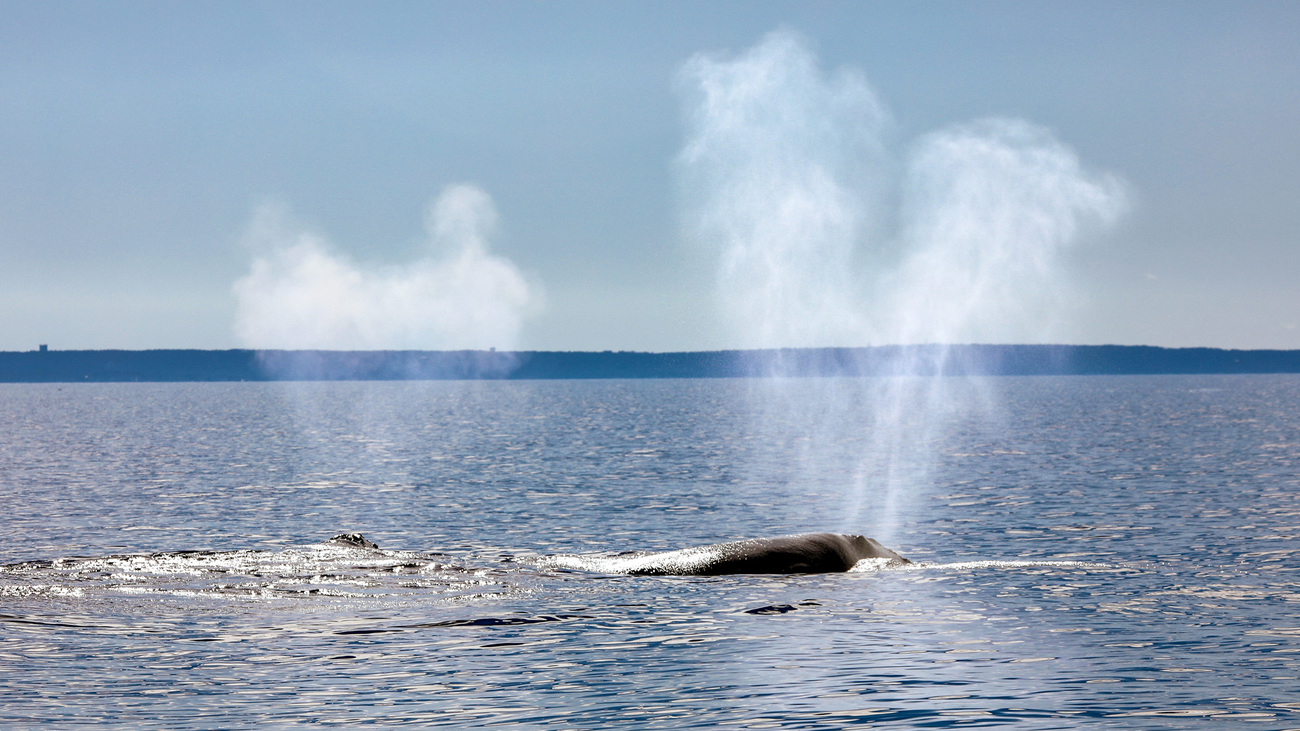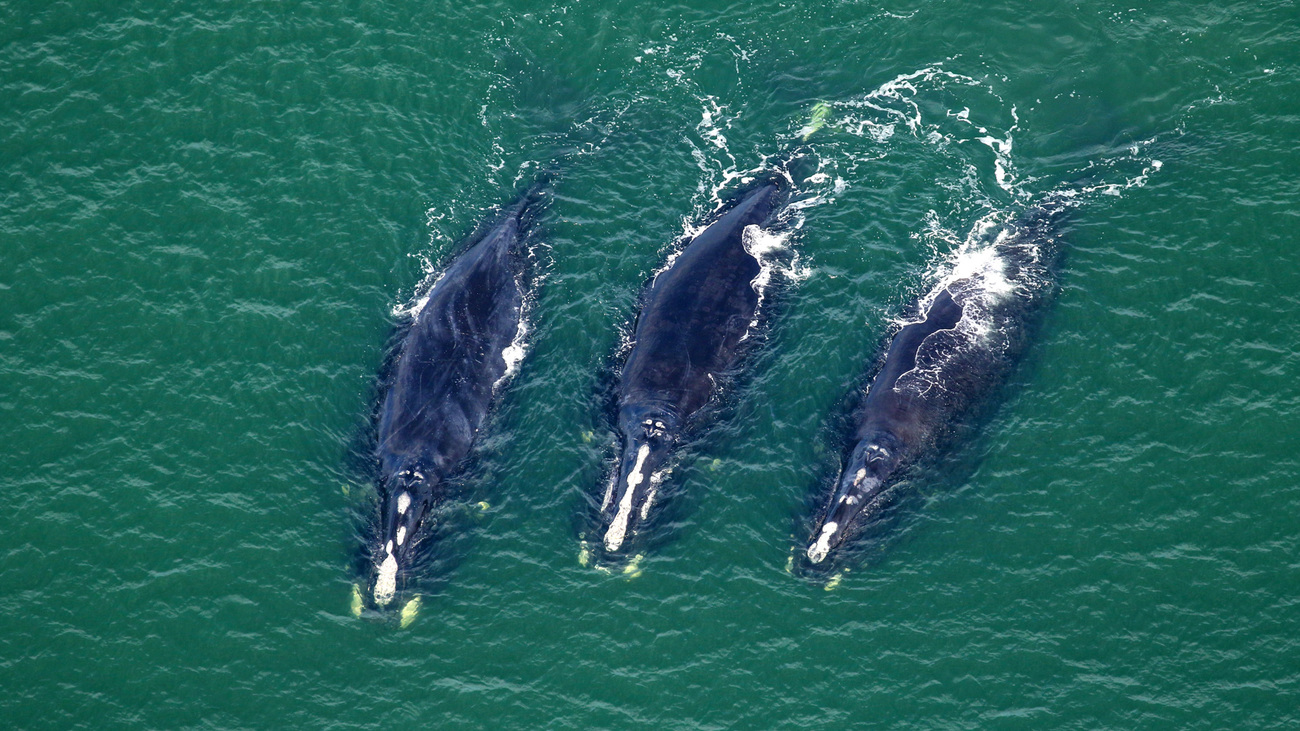Saving the North Atlantic right whale - North America
Don't fail our whaleSaving North Atlantic right whales: High-tech solutions to prevent vessel strikes
Saving North Atlantic right whales: High-tech solutions to prevent vessel strikes
Over the past seven years, 41 North Atlantic right whales have tragically lost their lives, with vessel strikes leading as the most common determinable cause of death. With only about 370 individuals remaining, including 70 breeding females, the species teeters on the brink of extinction.
In response, a bold and innovative approach to saving the North Atlantic right whale is taking shape along the US East Coast—thanks to a new partnership between IFAW, MotionInfo, Conserve.IO, and Stellwagen Bank National Marine Sanctuary. The solution? Automatic identification systems.
A game-changing solution
Together, we groups are working to reduce vessel strikes involving large whale species, including the critically endangered North Atlantic right whale, using Automatic Identification Systems (AIS) technology. This technology will deliver targeted safety messages and navigation data directly to vessels transiting whale habitats. All commercial vessels 65 feet and longer are required to carry the AIS collision avoidance system, and many other vessels carry it voluntarily to automatically receive vessel and voyage information from nearby vessels and view it on electronic navigation chart displays.
This project uses AIS in a novel way—using on-shore AIS send/receive stations controlled by custom software, the system automatically detects vessels operating in whale habitat and sends targeted messages directly to them. MotionInfo is implementing its A.W.A.R.E. AIS network and software, integrated with Conserve.IO’s compilation of marine mammal monitoring data, to create an automated, real-time communication network that pushes critical alerts directly to vessels operating in active speed zones and in areas where whales have recently been observed.
Shore stations along the US East Coast consist of an AIS transceiver and small antenna. Lightweight, 20-pound waterproof boxes hold all the electronics necessary to monitor AIS transmissions from vessels and transmit real-time messages directly to vessels with AIS systems. Alerts include crucial messages such as ‘you are entering,’ ‘you are leaving,’ or ‘you are going over the speed limit’ in regions with recent whale sightings and zones with mandatory or voluntary speed limits. These alerts, transmitted in both narrative and electronic navigation formats, appear directly on vessel navigation systems, prompting immediate action.

During a recent 20-day test conducted in collaboration with Dr. Dave Wiley, Research Ecologist with Stellwagen Bank National Marine Sanctuary, 83% of vessels slowed to 10 knots upon receiving these alerts and remained compliant with speed restrictions, demonstrating the system’s effectiveness.
With support from the US Coast Guard and NOAA, MotionInfo has installed active stations in Cape Cod Bay, Massachusetts; Virginia Beach, Virginia; Tybee Island, Georgia; Brunswick, Georgia; and Jacksonville, Florida. Additional funding is needed, as full network coverage will require up to 130 new stations on the East Coast. Stations are underway across Southeast locations, including Sapelo Island, Little Saint Simon’s Island, and Cumberland Island in Georgia, as well as Fernandina Beach, Jacksonville, St. Augustine, and Marineland in Florida. The full rollout will include additional critical regions for whale activity, such as Cape Cod Bay, the mouth of Chesapeake Bay, North Carolina, New York, and New Jersey.
Why this matters
The role of StationKeepers
MotionInfo is working with private companies, nonprofits, and federal and state government agencies to establish a comprehensive AIS network. To maintain onshore stations, StationKeepers can host transceiver stations and support installation and upkeep.
With assistance from IFAW, Tybee Island Marine Science Center, home to an impressive new North Atlantic right whale exhibit, became the first StationKeeper earlier this year. Chantal Audran, the Center’s executive director, is excited about the integration of this technology into their exhibit, as it combines public awareness, marine science education, and direct action to protect North Atlantic right whales.Recognizing the potential to protect species that migrate through the waters of Gray’s Reef National Marine Sanctuary, the National Marine Sanctuary Foundation is planning to fund several stations, bringing Georgia’s coastline close to being fully covered.
By recognizing and supporting StationKeepers and financial sponsors, this program not only protects whales but also fosters community engagement in marine conservation.
Targeted AIS alerts have the potential to transform how mariners interact with whale protection measures. By providing real-time, location-specific data, this system overcomes longstanding barriers to compliance. Mariners no longer need to rely on voluntary action or outdated information; instead, they receive timely nudges to modify their behavior.
Beyond vessel strike prevention, this system establishes a capability that could be used for other marine conservation challenges, and maritime safety and security measures, offering a scalable and flexible solution for a wide range of challenges.

A vision for impact
With AIS technology deployed along key stretches of the US East Coast, especially protected areas and active speed zones, this initiative aims to significantly reduce vessel strike risks by all vessels carrying AIS. Additionally, consumer marine electronics manufacturers, such as Garmin, are working to integrate similar messaging and electronic navigation data into their products, including off the shelf GPS chart plotters, expanding the project’s reach to recreational boaters as well.
As compliance improves and monitoring data becomes more robust, the network’s impact will only grow. This innovative system, made possible by conservation organizations, industry, and government partnership, offers new hope for the North Atlantic right whale and the health of our oceans.
Learn more about how IFAW and its partners are leveraging technology to protect marine wildlife and create a safer future for our ocean.
Interested in becoming a StationKeeper to protect endangered marine life? Visit MotionInfo.com.
Related content
Every problem has a solution, every solution needs support.
The problems we face are urgent, complicated, and resistant to change. Real solutions demand creativity, hard work, and involvement from people like you.